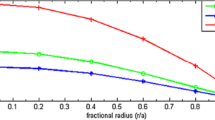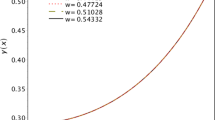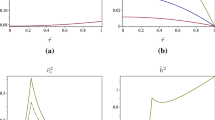Abstract
In this paper first ever we have developed a class of well behaved charged fluid spheres expressed by a space time with its hypersurfaces \(t = \operatorname {const}\). as spheroid for the case 0<K<1 with surface density 2×1014 gm/cm3. The same utilized to construct a superdense star and seen that star satisfies all well behaved condition for 0<K≤0.038. The maximum mass occupied and the corresponding radius are found to be 4.830982M Θ and 20.7612 km respectively. The redshift at the center and on the surface is given z 0=0.425367 and z a =0.240901.
Similar content being viewed by others
Avoid common mistakes on your manuscript.
1 Introduction
Since the inception of Reissner-Nordstrom metric, research workers have been busy in deriving interior regular charged perfect fluid solutions such as Tiwari et al. (1991), Tiwari and Ray (1991a, 1991b, 1993) and many more. Some of the workers, charged the well-known uncharged perfect fluid solutions e.g. Kuchowicz (1968) solutions by Nduka (1977), Adler (1974), Wyman (1949) solution by Nduka (1976) and so on a good account of the above can be had from the work of Ivanov (2002). The relevance of the study of charged fluid distributions is connected with the following interesting facts such as: (i) Charge dust (CD) (pressure free distribution) may be realized in the slight ionization of neutral hydrogen. (ii) CD may possess arbitrary mass and radius, can attain very large redshifts, their exteriors can be made arbitrarily near to the exterior of an extreme charged black hole. (iii) A classical model of an electron is likely to be represented by CD if many of its characteristics remain finite and non-trivial while the junction radius shrinks to zero. (iv) Besides many other speciality, the charge in the fluid distribution helps in countering the gravitational collapse by means of the Coulombian repulsion together with the pressure gradient. Although one can reach this goal with non perfect fluids, a perfect fluid solution of the type mentioned was recently found (Gupta and Kumar, 2005a) but with the presence of an electric charge. In the presence of electric charge the gravitational collapse of a spherically symmetric distribution of matter to a point singularity may be avoided as the gravitational attraction is counter balanced by the repulsive Coulombian force in addition to the negative pressure gradient due to the matter. Also presence of the charge, remove the gravitational collapse, which absorbs much of the fine tuning necessary in the uncharged case (Ivanov, 2002). After the model is charged thorough a specific electric intensity (Charge function) it starts possessing the negative density gradient which is necessary for a physically valid model. Vaidya and Tikekar (1982) coined a space-time involving a parameter K whose hypersurfaces t=constant were spheroids for K<1. They also obtained a perfect fluid distribution (for K=−2) which was utilized to describe a superdense star model. In fact the above space-time owes its origin to Buchdahl (1959) with a passage of time perfect fluid models were obtained for all K except for 0<K<1 by Gupta and Jasim (2003). Then the fluid spheres so obtained were electrified by means of a particular electric field (Gupta and Kumar, 2005a, 2005b; Sharma et al., 2001). It is observed that the case 0<K<1 fails to yield negative gradient of energy density for an uncharged case. Also Gupta and Kumar (2005c) has obtained most general class of charged fluid spheres described by space-time with hypersurfaces ‘\(t =\operatorname {const}\)’ as spheroids or hyperboloids considering the electric field intensity that has positive gradient. Recently, Gupta et al. (2010, 2011) discussed new closed form solutions for spheroid and hyperboloid, respectively considering a special form of charge profile satisfying ultra relativistic and non-relativistic conditions. Recently Naveen Bijalwan and Gupta (2011, 2012) have obtained perfect fluid charged analogues models for all K except for 0<K<1 using different electric intensity and Kumar and Gupta (2013) also obtained the Buchdhal’s type fluid with generalized charged intensity for 0<K≤0.05 which satisfies the reality conditions except casualty condition.
In this paper we have obtained a class of well-behaved charged fluid spheres satisfying the reality as well as casualty conditions and expressed by space time metric with its hypersurfaces \(t = \operatorname {const}\). as spheroid for the case 0<K<1. The charged fluid spheres so obtained are utilized to construct super-dense star models with surface density 2×1014 gm/cm3. In this process we come across various astrophysical objects like white dwarf, quark and neutron stars. A neutron star has mass between 1.35 and about 2.1 solar mass with a corresponding radius of about 12 km. It is shown by Chanderasekhar that no stable White Dwarf can be more massive than 1.42 solar mass. However 2 to 3 solar mass correspond to quark star.
2 Field equations
Let us take the static spherically symmetric space-time with \(t =\operatorname {const}\) hypersurfaces as spheroids or hyperboloids as
where C and K are constant parameters.
If the metric (2.1) describes charged fluid distribution then the metric has to satisfy the Einstein-Maxwell equations
where \(\kappa= \frac{8\pi G}{c^{4}}\), ρ, p and v i denote matter density, fluid pressure and the unit time-like flow vector of the fluid respectively and F ik being the skew symmetric electromagnetic field tensor satisfying the Maxwell equations
where j i=σv i represents the four-current vector of charged fluid while the charge density is denoted by σ.
The field equations (2.2) with respect to (2.1) reduce to (Dionysiou 1982)
where
represents the total charge contained with in the sphere of radius ‘r’. Equation (2.4) reduces to
Beyond the pressure free interface ‘r=a’ the charged fluid sphere is expected to join with the Reissner-Nordström metric:
where M is the gravitational mass of the distribution such that
while
ε(a) is the mass equivalence of the electromagnetic energy of distribution while μ(a) is the mass and e is the total charge inside the sphere (Florides 1983).
For the given expression of q, the expressions for the pressure and energy density can be had from (2.5) and (2.7) subject to the consistency of (2.6), which requires elimination of p.
If we let
then (2.12) transforms to a simple form
where
In order to obtained closed form solution of (2.14), when 0<K<1, then we get
Now put (2.15) into (2.14), we get
where
The electric intensity can be explicitly determined as
The expressions for density and pressure are given as
The expression for velocity of sound can be written as
Now we can solve (2.16) easily if we let,
The expression for the pressure can be derived as follows:
- Case (a)::
-
\(S = \frac{D}{X^{2}} = \frac{\beta}{X^{2}}\), \(\beta<\frac{1}{4}\)
$$ y ( X ) = \bigl( 1 + X^{2} \bigr)^{1/4} \bigl[ AX^{m_{1}} + BX^{m_{2}} \bigr] $$(2.22)where
$$m_{1} = \frac{1 + \sqrt{1 - 4\beta}}{2} \quad \mathrm{and}\quad m_{2} = \frac{1 - \sqrt{1 - 4\beta}}{2} $$The expression of the pressure is given as
$$\begin{aligned} \kappa p =& - \frac{2X^{2}}{KQ} \bigl[ \beta Q \bigl( Am_{1}X^{m_{1} - 1} + Bm_{2}X^{m_{2} - 1} \bigr) \\ &{} + 0.5X \bigl( AX^{m_{1}} + BX^{m_{2}}\bigr) \bigr] \bigl[Q \bigl( AX^{m_{1}} + BX^{m_{2}}\bigr)\bigr]^{-1} \\ &\times\frac{C}{ ( 1 - K )X} + \frac{C}{X^{2}} + \frac{C^{2}r^{2} ( 1 - K )^{2}}{2Q^{2}} \\ &{}\times \biggl[ \frac{5}{4KQ} - \frac{\beta Q}{KX^{2}} + 1 - \frac{7}{4K} \biggr] \end{aligned}$$(2.23)where
$$Q = \frac{1 + Cr^{2}}{1 - K} $$For numerically investigation of the models here we are taking following symbols throughout the article
$$D = \frac{8\pi G}{c^{2}}a^{2}\rho,\qquad P = \frac{8\pi G}{c^{4}}a^{2}p, $$c=2.997×1010 cm/s, G=6.673×10−8 cm3/gs2, M Θ =1.475 km.
- Case (b)::
-
\(S = \frac{D}{X^{2}} = \frac{\beta}{X^{2}}\), \(\beta=\frac{1}{4}\)
$$ y ( X ) = X^{1/2} \bigl( 1 + X^{2} \bigr)^{1/4} [ A + B\log X ] $$(2.24)The expression of the pressure is given as
$$\begin{aligned} \kappa p =& - \frac{2X^{2}}{KQ} \\ &{} \times \biggl[ \frac{\frac{BQ^{1/4}}{AX} + \frac{1}{2} ( 1 + \frac{B}{A}\log X ) ( Q^{ - 3/4}X^{3} + \frac{Q^{1/4}}{X} )}{QX ( 1 + \frac{B}{A}\log X )} \biggr] \\ &{}\times\frac{C}{ ( 1 - K )X} + \frac{C}{X^{2}} + \frac{C^{2}r^{2} ( 1 - K )^{2}}{2Q^{2}} \\ &{}\times \biggl[ \frac{5}{4KQ} - \frac{Q}{4KX^{2}} + 1 - \frac{7}{4K} \biggr] \end{aligned}$$(2.25)where
$$Q = \frac{1 + Cr^{2}}{1 - K} $$ - Case (c)::
-
\(S = \frac{D}{X^{2}} = \frac{\beta}{X^{2}}\), \(\beta> \frac{1}{4}\)
$$\begin{aligned} y ( X ) =& X^{1/2} \bigl( 1 + X^{2} \bigr)^{1/4} \bigl[ A\cos ( m_{1}\log X ) \\ &{} + B\sin ( m_{1}\log X ) \bigr] \end{aligned}$$(2.26)where \(m_{1} = \frac{\sqrt{4\beta- 1}}{2}\).
The expression of the pressure is given as
$$\begin{aligned} \kappa p =& - \frac{2X^{2}}{KQ}\biggl[ \biggl[ \frac{m_{1}Q^{1/4}}{X} \biggl\{ - \sin ( m_{1}\log X ) \\ &{} + \frac{B}{A}\cos ( m_{1}\log X ) \biggr\} + 0.5 \biggl\{ \cos ( m_{1}\log X ) \\ &{} + \frac{B}{A}\sin ( m_{1}\log X ) \biggr\} \bigl\{ Q^{- 3/4}X^{3} + Q^{1/4}X^{ - 1}\bigr\} \biggr] \\ &{}\times \biggl[{QX \biggl\{ \cos ( m_{1}\log X ) + \frac{B}{A}\sin ( m_{1}\log X ) \biggr\} } \biggr]\biggr]^{-1} \\ &{}\times\frac {C}{ ( 1 - K )X} + \frac{C}{X^{2}} + \frac{C^{2}r^{2} ( 1 - K )^{2}}{2Q^{2}} \\ &{}\times \biggl[ \frac{5}{4KQ} - \frac{\beta Q}{KX^{2}} + 1 - \frac{7}{4K} \biggr] \end{aligned}$$where
$$Q = \frac{1 + Cr^{2}}{1 - K} $$
3 Well behaved conditions to be satisfied
The physical validity of the charged fluid sphere (CFS) depends upon the following conditions (called reality conditions or energy conditions) inside and on the sphere r=a such that
-
(i)
ρ>0, 0≤r≤a,
-
(ii)
p>0, r<a,
-
(iii)
p=0, r=a,
-
(iv)
dp/dr<0,dρ/dr<0,0<r<a.
-
(v)
c 2 ρ≥p weak energy condition (WEC) or c 2 ρ≥3p strong energy condition (SEC) 0≤r≤a.
-
(vi)
The velocity of sound (dp/dρ)1/2 should be less than that of light throughout the CFS (0≤r≤a).
-
(vii)
\(\frac{d}{dr} ( \frac{p}{c^{2}\rho} ) < 0\).
-
(viii)
\(\frac{d}{dr} ( \frac{dp}{c^{2}d\rho} ) < 0\).
-
(ix)
The adiabatic constant \(\gamma=(( \frac{c^{2}\rho+ p}{p} ) ( \frac{dp}{c^{2}d\rho} ) ) > 1\).
-
(x)
Red Shift red as (e −ν/2−1) or \((\frac{1}{\vert y ( r ) \vert } - 1)\)
Beside the above the smooth joining with the Reissner-Nordström metric, requires the continuity of e λ, e υ and q across the pressure free interface r=a and we get,
The conditions (3.1) and (3.3) are automatically satisfied due to the preposition (2.11) however (3.2) and (3.4) can provide the unique values of arbitrary constants A and B.
4 Conclusion
In this paper the fluid spheres is electrified in a particular way which leads to a second order differential equation in normal form with g 44=(1+X 2)1/2 v 2 and \(\frac{d^{2}v}{dr^{2}} + Sv = 0\). The later is solved for three cases, but only one case i.e. \(S = \frac{\beta}{X^{2}}\), \(( \beta< \frac{1}{4} )\) could yield the charged fluid spheres satisfying all the well behaved conditions for 0<K≤0.038 and depict the models for super dense star with the maximum mass and the corresponding radius as 4.830982M Θ and 20.7612 km respectively for K=0.02 with red shifts at the center and on the surface are given by z 0=0.425367 and z a =0.240901 respectively (where surface density is taken to be 2×1014 g/cm3). The star models are seen to satisfy Chandrasekhar limit. In this article we come across various astrophysical objects like white dwarf, quark and neutron stars with the masses 1.342129M, 4.830982M Θ and 1.584497M Θ respectively and the corresponding radius are 14.29049 km, 20.7612 km and 15.03099 km respectively. Also in the cases (b) and (c) from the numerical Tables 5, 6, 7, 8 we have concluded that due to positive density gradient for all numerical values of K, Ca 2 and β, all the mentioned cases are unphysical. Finally through the numerically as well as graphically investigations we have concluded that only the case (a) is satisfied the well behaved conditions of the charged fluid sphere. Here we have constructed the graphs only for well behaved case (Tables 1, 2, 3, 4).
Figure 1 shown that the pressure (P) is monotonically decreasing with respect to radius for the various values of the parameter K.
Figure 2 shown that the density (D) is monotonically decreasing with respect to radius for the various values of the parameter K.
Figure 3 shown that the charge (q) is monotonically increasing with respect to radius for the various values of the parameter K.
Figure 4 shown that the velocity of sound is monotonically decreasing with respect to radius for the various values of the parameter K.
Figure 5 shows that the ratio (P/D) of pressure and density is monotonically decreasing with respect to radius for the various values of the parameter K.
References
Adler, R.J.: A fluid sphere in general relativity. J. Math. Phys. 15, 729 (1974)
Bijalwan, N., Gupta, Y.K.: Closed form charged fluid with t=constant hypersurfaces as spheroids and hyperboloids. Astrophys. Space Sci. 337, 455–462 (2012). doi:10.1007/s10509-011-0823-6
Bijalwan, N., Gupta, Y.K.: Closed form Vaidya-Tikekar type charged fluid spheres with pressure. Astrophys. Space Sci. 334, 293–299 (2011). doi:10.1007/s10509-011-0735-5
Buchdahl, H.A.: General relativistic fluid spheres. Phys. Rev. 116, 1027 (1959)
Dionysiou, D.D.: Equilibrium of a static charged perfect fluid sphere. Astrophys. Space Sci. 85, 331 (1982)
Florides, P.S.: The complete field of charged perfect fluid spheres and of other static spherically symmetric charged distributions. J. Phys. A, Math. Gen. 17, 1419 (1983)
Gupta, Y.K., Jasim, M.K.: On the most general accurte solutions for Buchdahl’s fluid spheres. Astrophys. Space Sci. 283, 337–346 (2003)
Gupta, Y.K., Kumar, M.: A superdense star model as charged analogue of Schwarzschild’s interior solution. Gen. Relativ. Gravit. 37(1), 575 (2005a)
Gupta, Y.K., Kumar, M.: On charged analogues of Buchdahl’s type fluid spheres. Astrophys. Space Sci. 299(1), 43–59 (2005b)
Gupta, Y.K., Kumar, M.: On the general solution for a class of charged fluid spheres. Gen. Relativ. Gravit. 37(1), 233 (2005c)
Gupta, Y.K., Pratibha, Sharma, J.R.: Int. J. Mod. Phys. A 25, 1863 (2010)
Gupta, Y. K., Pratibha, Kumar, J.: A new class of charged analogues of Vaitya’s-Tikekar type superdense star. Astrophys. Space Sci. 333(1), 143–148 (2011)
Ivanov, B.V.: Static charged perfect fluid spheres in general relativity. Phys. Rev. D, Part. Fields 65, 104001 (2002)
Kuchowicz, B.: General relativistic fluid spheres. I. New solutions for spherically symmetric matter distribution. Acta Phys. Pol. 33, 541 (1968)
Kumar, J., Gupta, Y.K.: A class of new solutions of generalized charged analogues of Buchdahl’s type super-dense star. Astrophys. Space Sci. 345, 331–337 (2013)
Nduka, A.: Charged fluid spheres in general relativity. Gen. Relativ. Gravit. 7, 493 (1976)
Nduka, A.: Charged static fluid spheres in Einstein-Cartan theory. Acta Phys. Pol. B 75 (1977)
Sharma, R., Mukherjee, S., Maharaj, S.D.: General solution for a class of static charged spheres. Gen. Relativ. Gravit. 33, 999 (2001)
Tiwari, R.N., Ray, S.: Astrophys. Space Sci. 180, 143 (1991a)
Tiwari, R.N., Ray, S.: Astrophys. Space Sci. 182, 105 (1991b)
Tiwari, R.N., Ray, S.: Astrophys. Space Sci. 199, 333 (1993)
Tiwari, R.N., Rao, J.R., Ray, S.: Astrophys. Space Sci. 178, 119–132 (1991)
Vaidya, P.C., Tikekar, R.: Exact relativistic model for a superdense star. J. Astrophys. Astron. 3, 325 (1982)
Wyman, M.: Radially symmetric distributions of matter. Phys. Rev. 75, 1930 (1949)
Author information
Authors and Affiliations
Corresponding author
Rights and permissions
About this article
Cite this article
Kumar, J., Gupta, Y.K. A class of well-behaved generalized charged analogues of Vaidya-Tikekar type fluid sphere in general relativity. Astrophys Space Sci 351, 243–250 (2014). https://doi.org/10.1007/s10509-013-1772-z
Received:
Accepted:
Published:
Issue Date:
DOI: https://doi.org/10.1007/s10509-013-1772-z









